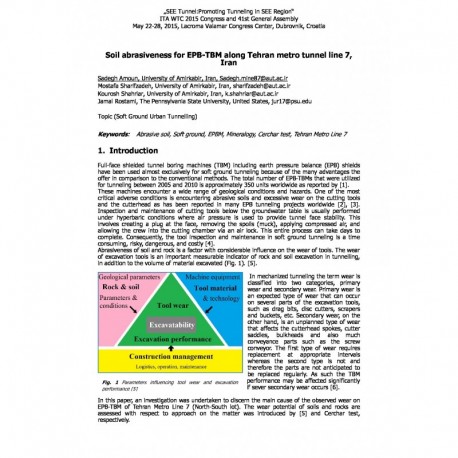Cart
0
0
No document
0,00 €
Total
Document successfully added to your shopping cart
Quantity
Total
There are 0 items in your cart.
There is 1 item in your cart.
Total documents
Total shipping
To be determined
Total
Search & filter
Search for a publication
Search & filter
Viewed documents

Soil abrasiveness for EPB-TBM along Tehran metro tunnel line 7, Iran
wtc2015_full_amoun-1
J. Rostami / M. Sharifzadeh / K. Shahriar / S. Amoun
Full-face shielded tunnel boring machines (TBM) including earth pressure balance (EPB) shields have been used almost exclusively for soft ground tunneling because of the many advantages the offer in comparison to the conventional methods. The total number of EPB-TBMs that were utilized for tunneling between 2005 and 2010 is approximately 350 units worldwide as reported by [1]. These machines encounter a wide range of geological conditions and hazards. One of the most critical adverse conditions is encountering abrasive soils and excessive wear on the cutting tools and the cutterhead as has been reported in many EPB tunneling projects worldwide [2], [3]. Inspection and maintenance of cutting tools below the groundwater table is usually performed under hyperbaric conditions where air pressure is used to provide tunnel face stability. This involves creating a plug at the face, removing the spoils (muck), applying compressed air, and allowing the crew into the cutting chamber via an air lock. This entire process can take days to complete. Consequently, the tool inspection and maintenance in soft ground tunneling is a time consuming, risky, dangerous, and costly [4]. Abrasiveness of soil and rock is a factor with considerable influence on the wear of tools. The wear of excavation tools is an important measurable indicator of rock and soil excavation in tunnelling, in addition to the volume of material excavated (Fig. 1). [5]. In mechanized tunneling the term wear is classified into two categories, primary wear and secondary wear. Primary wear is an expected type of wear that can occur on several parts of the excavation tools, such as drag bits, disc cutters, scrapers and buckets, etc. Secondary wear, on the other hand, is an unplanned type of wear that affects the cutterhead spokes, cutter saddles, bulkheads and also much conveyance parts such as the screw conveyor. The first type of wear requires replacement at appropriate intervals whereas the second type is not and therefore the parts are not anticipated to be replaced regularly. As such the TBM performance may be affected significantly if sever secondary wear occurs [6]. In this paper, an investigation was undertaken to discern the main cause of the observed wear on EPB-TBM of Tehran Metro Line 7 (North-South lot). The wear potential of soils and rocks are assessed with respect to approach on the matter was introduced by [5] and Cerchar test, respectively.


